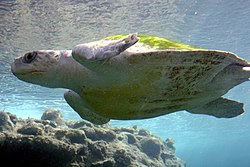Tasbacka is an extinct genus of sea turtle containing several species.[1][3]
Though the type species, T. aldabergeni, has only been found in Kazakhstan,[4] Tasbacka had a wide distribution. T. ruhoffi was found in the eastern USA,[5] T. danica in modern Denmark, T. ouledabdounensis in modern Morocco, T. salisburgensis in modern Austria,[3] and T. germanica in modern Germany.[2]
In 2008, researchers found a well-preserved, juvenile specimen of T. danica in Denmark's Fur Formation.[6] Some of the fossil's soft tissues remained.[7] The specimen, dating back to 54 Ma, contained eumelanin. This pigment would've given the hatchling a dark shell while it was alive. Modern sea turtle hatchlings also have dark shells; while a hatchling floats on the ocean's surface, its dark coloring enables it to absorb heat from the sun and avoid predatory birds. The existence of similar pigment on an ancient specimen suggests sea turtles evolved this survival trait millions of years ago.[6]
References
- ^ a b "†Tasbacka Nesov 1986 (sea turtle)". Paleobiology Database. Fossilworks. Retrieved 25 January 2022.
- ^ a b Karl, H.-V.; Gröning, E.; Brauckmann, C. (2019). "Tasbacka germanica n. sp., a new Campanian marine turtle from NW-Germany (Testudines: Chelonioidea)". Mainzer Naturwissenschaftliches Archiv. 56: 99–112.
- ^ a b Karl, H.-V.; Madsen, H. (2012). "Tasbacka danica n. sp., a new Eocene marine turtle of Denmark (Testudines: Chelonioidea)" (PDF). Studia Palaeocheloniologica. 4: 193–204.
- ^ "†Tasbacka aldabergeni Nessov 1987 (sea turtle)". Paleobiology Database. Fossilworks.
- ^ "†Tasbacka ruhoffi Weems 1988 (sea turtle)". Paleobiology Database. Fossilworks.
- ^ a b Peake, Tracey (October 17, 2017). "Keratin, Pigment, Proteins From 54 Million-Year-Old Sea Turtle Show Survival Trait Evolution". NC State University News. North Carolina State University.
- ^ "Danekræ fossil trove collection". Statens Naturhistoriske Museum Samlinger (in Danish).
A complete juvenile sea-turtle referred to the new species Tasbacka danica, with soft tissue preservation and outstanding exhibition value.



Recent Comments